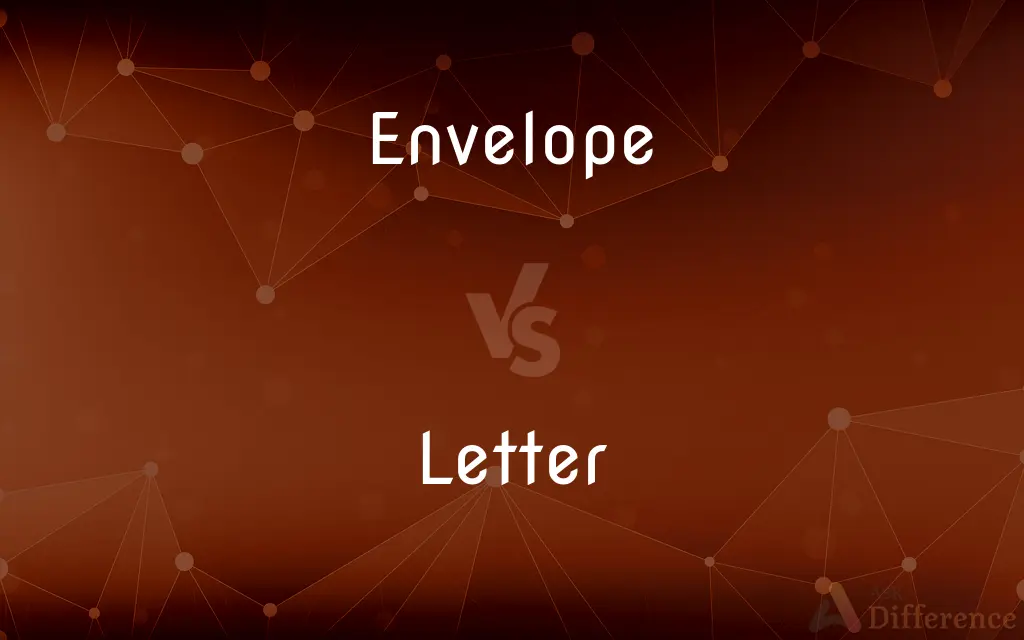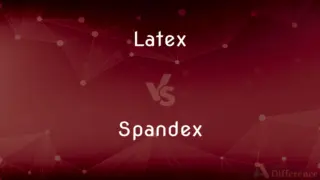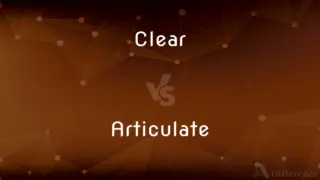Envelope vs. Letter — What's the Difference?
By Fiza Rafique & Urooj Arif — Updated on April 4, 2024
An envelope is a paper or plastic covering for a letter, while a letter is a written message from one person to another.

Difference Between Envelope and Letter
Table of Contents
ADVERTISEMENT
Key Differences
An envelope serves as a protective covering for a letter or document, designed to conceal its contents and provide information such as the address of the recipient and sender. On the other hand, a letter is a form of written communication, typically consisting of a message from one individual to another.
While the envelope acts as a vessel for delivering the letter, protecting it from physical damage and ensuring privacy, the letter itself is the core of the communication, containing the message intended for the recipient. This distinction highlights the complementary nature of envelopes and letters, with each playing a unique role in the process of written communication.
In modern times, the significance of letters and envelopes has evolved with the advent of digital communication. However, they remain emblematic of personal and thoughtful communication, often reserved for occasions when a more personal touch is desired or when official documents need to be physically exchanged.
Despite their differences, both envelopes and letters are essential components of postal communication. An envelope without a letter serves no purpose, and a letter without an envelope cannot be securely or effectively delivered. This interdependence underscores the importance of both elements in ensuring effective written communication.
Comparison Chart
Purpose
To protect and conceal the contents (a letter or document) during delivery.
To convey a written message from one person to another.
ADVERTISEMENT
Material
Made of paper, plastic, or other materials suitable for mailing.
Usually written on paper.
Contents
Addresses of the sender and recipient, sometimes postage.
Written text conveying news, information, emotions, or instructions.
Function
Ensures the privacy and security of the letter’s contents; aids in delivery.
The core of communication; contains the actual message intended for the recipient.
Variety
Comes in various sizes and designs to accommodate different types of contents.
Can vary in format, style, and length, from personal notes to formal documents.
Compare with Definitions
Envelope
Protective covering for sending documents through the mail.
The official documents were sealed in a padded envelope.
Letter
Can contain various types of information or emotions.
The letter expressed joy at the recent family news.
Envelope
Comes in various sizes and materials.
For the wedding invitations, they chose custom-designed envelopes.
Letter
A written message addressed to a person or organization.
He wrote a letter of apology to his friend.
Envelope
A flat, usually rectangular or square, container for a letter.
She addressed the envelope and affixed a stamp.
Letter
Can be personal or formal in nature.
The lawyer drafted a formal letter to the court.
Envelope
Aids in the sorting and delivery of mail.
The color-coded envelope indicated priority mail.
Letter
Often consists of a greeting, body, closing, and signature.
Her letters always started with a warm greeting and ended with love.
Envelope
Used to ensure the confidentiality of the letter’s contents.
The confidential report was placed in a secure envelope.
Letter
Used for communication across distances.
Before email, they kept in touch through letters.
Envelope
An envelope is a common packaging item, usually made of thin, flat material. It is designed to contain a flat object, such as a letter or card.
Letter
A character representing one or more of the sounds used in speech; any of the symbols of an alphabet
A capital letter
Envelope
A flat paper container with a sealable flap, used to enclose a letter or document.
Letter
A written, typed, or printed communication, sent in an envelope by post or messenger
He sent a letter to Mrs Falconer
Envelope
A covering or containing structure or layer
The external envelope of the swimming pool
Letter
The precise terms of a statement or requirement; the strict verbal interpretation
We must keep the spirit of the law as well as the letter
The officer in the incident got in trouble for following the letter of the law
Envelope
A flat paper container, especially for a letter, usually having a gummed flap.
Letter
Literature
The world of letters
Envelope
Something that envelops; a wrapping.
Letter
A style of typeface.
Envelope
(Biology) An enclosing structure or cover, such as a membrane or the outer coat of a virus.
Letter
Inscribe letters or writing on
Her name was lettered in gold
Envelope
The bag containing the gas in a balloon or airship.
Letter
Be given a school or college initial as a mark of proficiency in sport
In high school she lettered in soccer, basketball and softball
Envelope
The set of limitations within which a technological system, especially an aircraft, can perform safely and effectively.
Letter
A written symbol or character representing a speech sound and being a component of an alphabet.
Envelope
A usually spherical region of interstellar matter surrounding a forming star and interacting with the star's gravitational and radiation fields.
Letter
A written symbol or character used in the graphemic representation of a word, such as the h in Thames. See Note at Thames.
Envelope
The coma of a comet.
Letter
A written or printed communication directed to a person or organization.
Envelope
(Mathematics) A curve or surface that is tangent to every one of a family of curves or surfaces.
Letter
Often letters A certified document granting rights to its bearer.
Envelope
A paper or cardboard wrapper used to enclose small, flat items, especially letters, for mailing.
Letter
Literal meaning
Had to adhere to the letter of the law.
Envelope
Something that envelops; a wrapping.
Letter
Literary culture; belles-lettres.
Envelope
A bag containing the lifting gas of a balloon or airship; fabric that encloses the gas-bags of an airship.
Letter
Learning or knowledge, especially of literature.
Envelope
(geometry) A mathematical curve, surface, or higher-dimensional object that is the tangent to a given family of lines, curves, surfaces, or higher-dimensional objects. Category:en:Curves
Letter
Literature or writing as a profession.
Envelope
(electronics) A curve that bounds another curve or set of curves, as the modulation envelope of an amplitude-modulated carrier wave in electronics.
Letter
A piece of type that prints a single character.
Envelope
(music) The shape of a sound, which may be controlled by a synthesizer or sampler.
Letter
A specific style of type.
Envelope
(computing) The information used for routing a message that is transmitted with the message but not part of its contents.
Letter
The characters in one style of type.
Envelope
(biology) An enclosing structure or cover, such as a membrane; a space between two membranes
Letter
An emblem in the shape of the initial of a school awarded for outstanding performance, especially in varsity athletics.
Envelope
(engineering) The set of limitations within which a technological system can perform safely and effectively.
Letter
To write letters on
Lettered the paper.
Envelope
(astronomy) The nebulous covering of the head or nucleus of a comet; a coma.
Letter
To write in letters
Lettered our name on the mailbox.
Envelope
An earthwork in the form of a single parapet or a small rampart, sometimes raised in the ditch and sometimes beyond it.
Letter
To write or form letters.
Envelope
Archaic form of envelop
Letter
To earn a school letter, as for outstanding athletic achievement
She lettered in three collegiate sports.
Envelope
That which envelops, wraps up, encases, or surrounds; a wrapper; an inclosing cover; esp., the cover or wrapper of a document, as of a letter.
Letter
A symbol in an alphabet.
There are twenty-six letters in the English alphabet.
Envelope
The nebulous covering of the head or nucleus of a comet; - called also coma.
Letter
A written or printed communication, generally longer and more formal than a note.
I wrote a letter to my sister about my life.
Envelope
A work of earth, in the form of a single parapet or of a small rampart. It is sometimes raised in the ditch and sometimes beyond it.
Letter
The literal meaning of something, as distinguished from its intended and remoter meaning (the spirit).
Envelope
A curve or surface which is tangent to each member of a system of curves or surfaces, the form and position of the members of the system being allowed to vary according to some continuous law. Thus, any curve is the envelope of its tangents.
Letter
Literature.
Benjamin Franklin was multiskilled – a scientist, politician and a man of letters.
Envelope
A set of limits for the performance capabilities of some type of machine, originally used to refer to aircraft; - it is often described graphically as a two-dimensional graph of a function showing the maximum of one performance variable as a function of another. Now it is also used metaphorically to refer to capabilities of any system in general, including human organizations, esp. in the phrase push the envelope. It is used to refer to the maximum performance available at the current state of the technology, and therefore refers to a class of machines in general, not a specific machine.
Letter
(law) A division unit of a piece of law marked by a letter of the alphabet.
Letter (b) constitutes an exception to this provision.
Envelope
A flat rectangular paper container for papers
Letter
A size of paper, 8½ in × 11 in (215.9 mm × 279.4 mm, US paper sizes rounded to the nearest 5 mm).
Envelope
Any wrapper or covering
Letter
A size of paper, 215 mm × 280 mm.
Envelope
A curve that is tangent to each of a family of curves
Letter
Clipping of varsity letter
Envelope
A natural covering (as by a fluid);
The spacecraft detected an envelope of gas around the comet
Letter
A single type; type, collectively; a style of type.
Envelope
The maximum operating capability of a system;
Test pilots try to push the envelope
Letter
(archaic) One who retards or hinders.
Envelope
The bag containing the gas in a balloon
Letter
(transitive) To print, inscribe, or paint letters on something.
Letter
To earn a varsity letter (award).
Letter
One who lets or permits; one who lets anything for hire.
Letter
One who retards or hinders.
Letter
A mark or character used as the representative of a sound, or of an articulation of the human organs of speech; a first element of written language.
And a superscription also was written over him in letters of Greek, and Latin, and Hebrew.
Letter
A written or printed communication; a message expressed in intelligible characters on something adapted to conveyance, as paper, parchment, etc.; an epistle.
The style of letters ought to be free, easy, and natural.
Letter
A writing; an inscription.
None could expound what this letter meant.
Letter
Verbal expression; literal statement or meaning; exact signification or requirement.
We must observe the letter of the law, without doing violence to the reason of the law and the intention of the lawgiver.
I broke the letter of it to keep the sense.
Letter
A single type; type, collectively; a style of type.
Under these buildings . . . was the king's printing house, and that famous letter so much esteemed.
Letter
Learning; erudition; as, a man of letters.
Letter
A letter; an epistle.
Letter
A telegram longer than an ordinary message sent at rates lower than the standard message rate in consideration of its being sent and delivered subject to priority in service of regular messages. Such telegrams are called by the Western Union Company day letters, or night letters according to the time of sending, and by The Postal Telegraph Company day lettergrams, or night lettergrams.
A strange lock that opens with AMEN.
Letter
To impress with letters; to mark with letters or words; as, a book gilt and lettered.
Letter
A written message addressed to a person or organization;
Mailed an indignant letter to the editor
Letter
The conventional characters of the alphabet used to represent speech;
His grandmother taught him his letters
Letter
A strictly literal interpretation (as distinct from the intention);
He followed instructions to the letter
He obeyed the letter of the law
Letter
An award earned by participation in a school sport;
He won letters in three sports
Letter
Owner who lets another person use something (housing usually) for hire
Letter
Win an athletic letter
Letter
Set down or print with letters
Letter
Mark letters on or mark with letters
Common Curiosities
Are envelopes only used for letters?
No, envelopes can also be used to send documents, cards, and small items, depending on their size and design.
Can envelopes be recycled?
Yes, most paper envelopes can be recycled, but envelopes with plastic windows or made of certain materials may need to be separated or cannot be recycled.
What is the main purpose of an envelope?
The main purpose of an envelope is to protect and conceal a letter or document during delivery, ensuring it reaches the recipient securely.
Can a letter be sent without an envelope?
Technically, yes, but using an envelope is standard practice for privacy and to protect the letter during transit.
How do you properly address an envelope?
To properly address an envelope, write the recipient's name and address on the front center and the sender's address in the top left corner or on the back flap.
How has digital communication affected the use of letters and envelopes?
Digital communication has reduced the frequency of sending letters and envelopes for everyday communication, but they remain popular for official, formal, or personal messages that require a more personal touch.
Are there different types of letters?
Yes, there are various types of letters, including personal letters, business letters, official letters, and others, each serving different purposes.
Why are letters considered more personal than emails?
Letters are considered more personal due to the effort in writing and sending them through physical mail, offering a tangible sense of connection and thoughtfulness.
What makes a letter personal?
A letter becomes personal through its content, which may include personal news, emotions, and a direct message from the sender to the recipient.
What information is typically found on an envelope?
An envelope typically displays the recipient's and sender's addresses and may also include postage and sometimes instructions for the postal service.
Share Your Discovery

Previous Comparison
Latex vs. Spandex
Next Comparison
Clear vs. ArticulateAuthor Spotlight
Written by
Fiza RafiqueFiza Rafique is a skilled content writer at AskDifference.com, where she meticulously refines and enhances written pieces. Drawing from her vast editorial expertise, Fiza ensures clarity, accuracy, and precision in every article. Passionate about language, she continually seeks to elevate the quality of content for readers worldwide.
Co-written by
Urooj ArifUrooj is a skilled content writer at Ask Difference, known for her exceptional ability to simplify complex topics into engaging and informative content. With a passion for research and a flair for clear, concise writing, she consistently delivers articles that resonate with our diverse audience.
















































